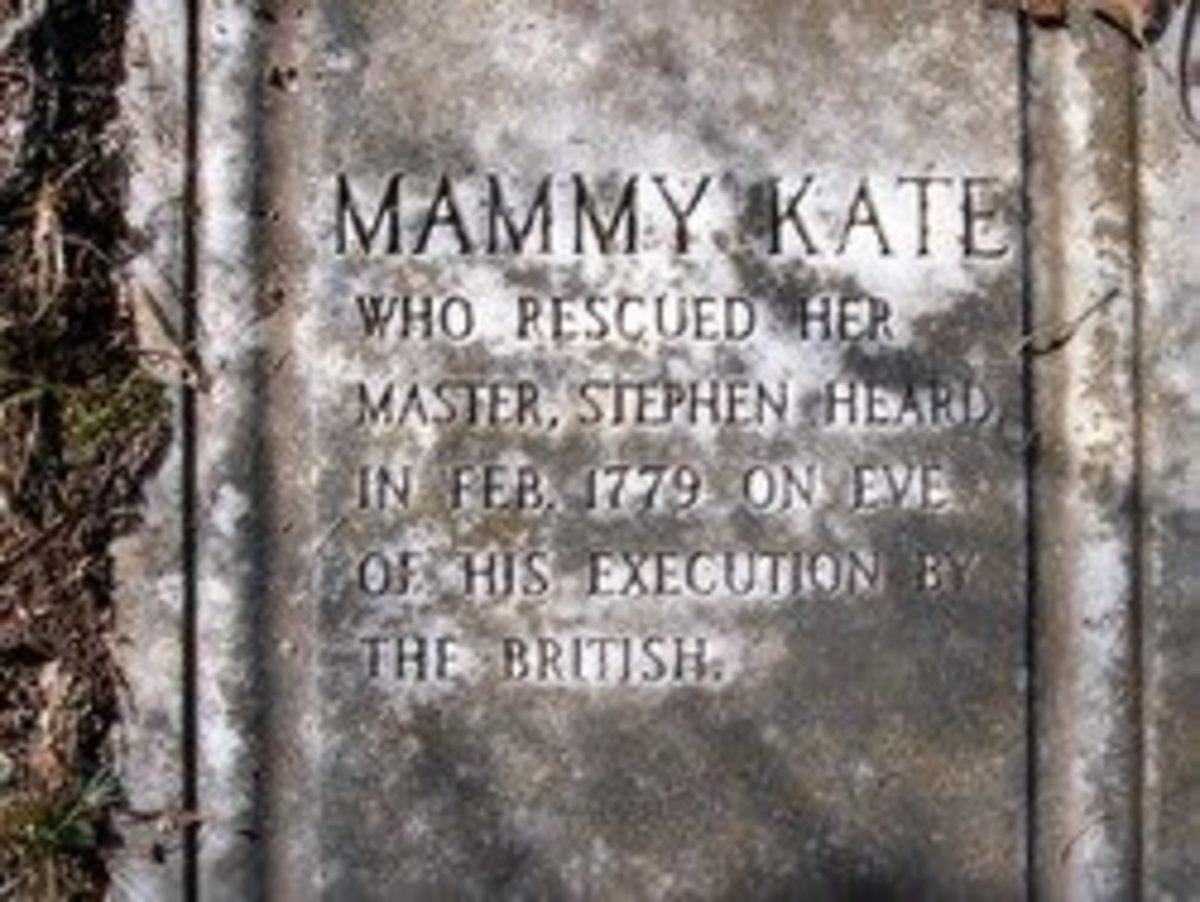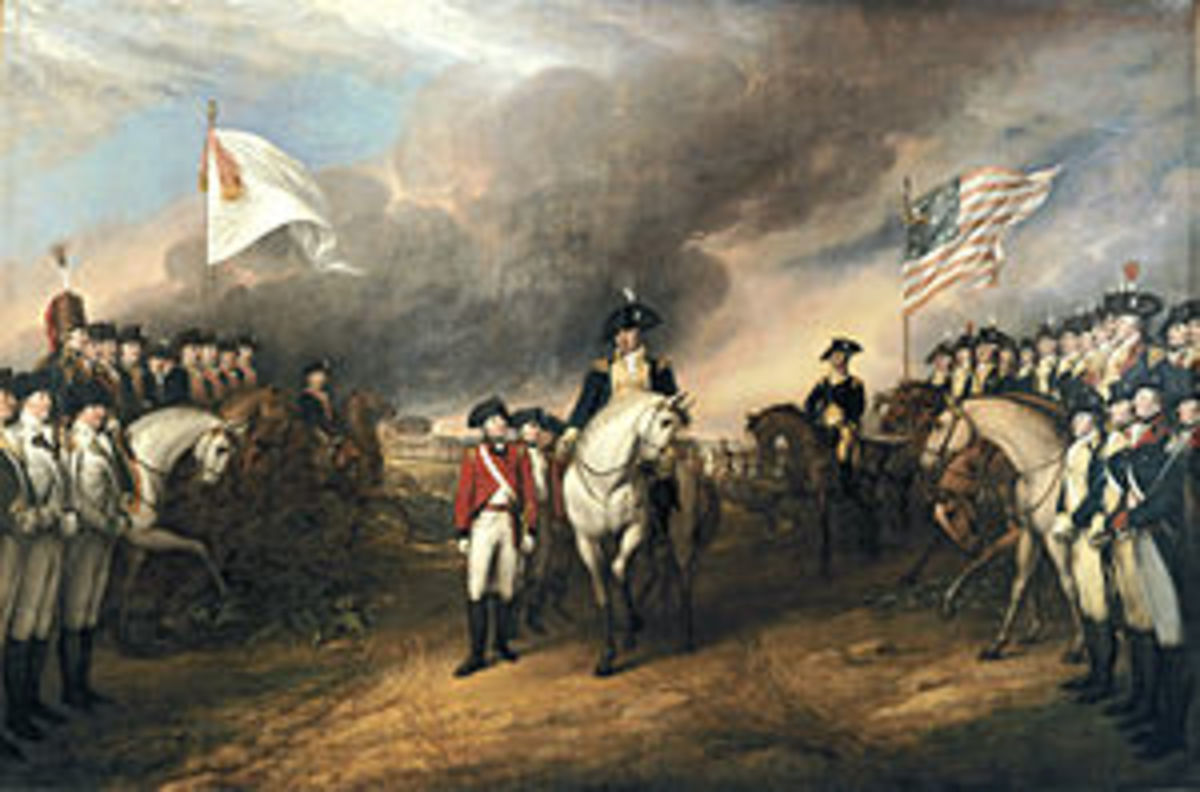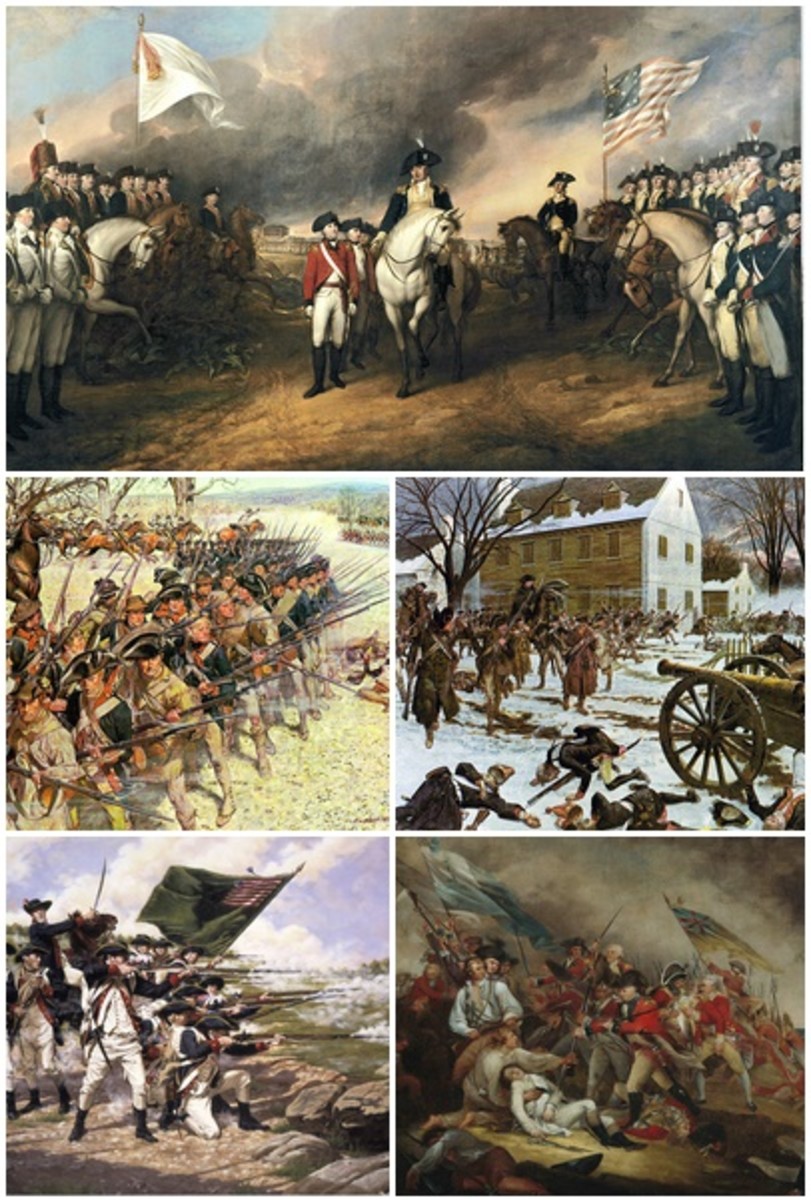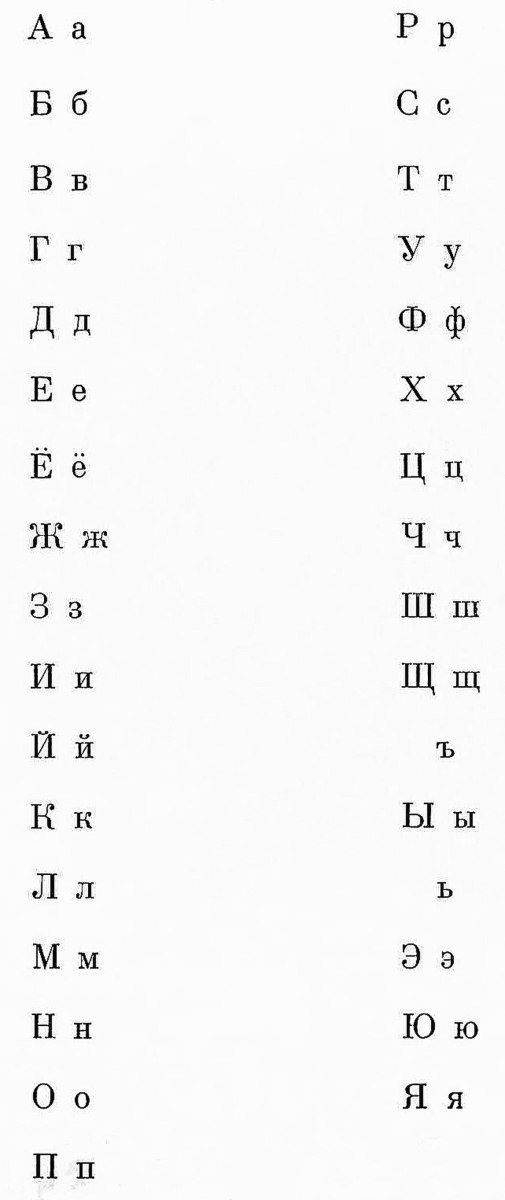The American Revolutionary War
George Washington
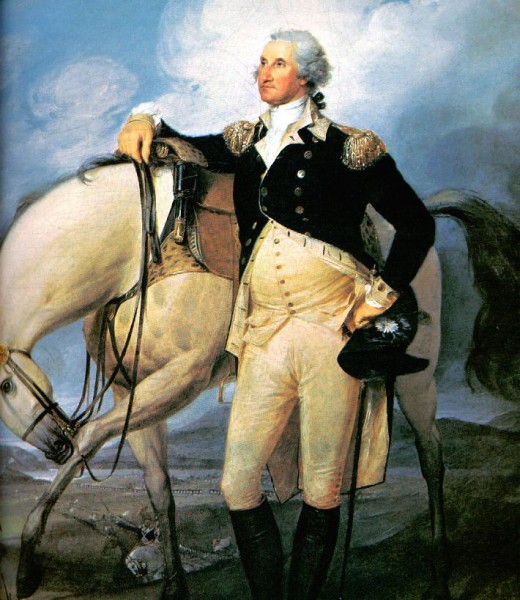
Thomas Jefferson
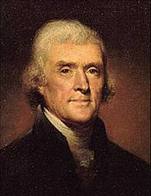
Ben Franklin
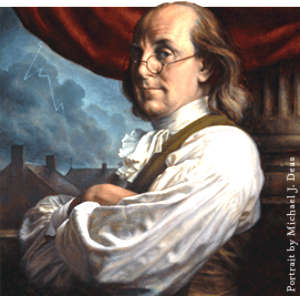
The Revolutionary War (1776-1783)
Like many other countries, the United States of America was born in a revolution. The stirrings of discontent between the American Colonies and its British masters began with theFrench-Indian War.
The French-Indian War, also known as the Seven Years War (1756-1763),ended with the American colonists aiding British soldiers in defeating the French forces stationed in America. (Native Americas fought on both sides but mostly for the French.) France lost all its possessions in the North America and most of what they'd owned in Canada. This led to the Treaty of Paris which gave Great Britain sole control over North America.
After that war, the Albany Congress (New York was the capital of the 13 Colonies at the time) wrote the Articles of Confederation, which served as a precursor to the US Constitution. Article One of the document specifically named the colonies as "the Unites States of America". The Colonists were feeling Confident and strong, having driven off the French. They imagined an unfounded sense of autonomy from the British. The Articles of Confederation set down a new series of rules in America.
The Articles highlighted differences in thought and interests between Great Britain and the Colonies. Local political practices and business styles diverged greatly between the two cultures. Social customs, religious beliefs and economic interests added to the potential for conflict.
Two years after the Seven Years War ended, Britain was suffering a massive economic deficit due to the strain on its resources incurred during the war with France. They needed to bolster their economy somehow. Many British politicians were of the opinion that the American colonies had enjoyed a free ride on the backs of the British Empire for far too long. George Grenville championed a new policy to redress the balance by using taxes to make the Colonies pay for their defense cost and bring revenue to the mother country.
The British began tax levies on molasses and sugar in 1764. This caused huge protests in America because the colonists considered these taxes illegal. The British maintained that these taxes were legal and fair.
The Colonists saw the law differently than the British saw it. According to American law, this was taxation without representation. They considered the fact that there was no legal representative from the colonies present negated the legality of the ruling. They maintained that they had a right to have their voice heard in any decision regarding their welfare. Therefore, they believed, Parliament couldn't tax them without them having a vote.
To the British, the matter was very different. The British believed in "Virtual Representation". According to British law, the House of Commons represented all British subjects by proxy. Under the rules of Virtual Representation, Parliament could legally tax the Colonies and make laws for them, even if no indigenous member of the Colonies was present.
America did not want to pay and this led to tensions with Britain. Requests were sent to King George asking him to repeal the new taxes but he refused. Tensions were heightened when the Stamp act (A law that mandated all printed materials had to be printed on paper stamped and approved by the British government) was passed in 1764. Even worse for the colonies was King George's promise of strict enforcement of these new laws.
The presence of British troops--often called "Redcoats"--increased in the Colonies, making the Americans feel very uneasy. This led to the event known today as the Boston Massacre.
Aside from the increase in troops, Bostonians had been further angered when a British ship seized a sloop owned by a prominent businessman named John Hancock on suspicion of smuggling. Customs official were so nervous about the growing anti-British sentiment that they had armed troops guarding the customs house.
A group of civilians surrounded the customs house and began taunting the soldiers, pelting them with snowballs and sticks. This led a nervous Private named Hugh White to fire, and the other soldiers began shooting as well. Three people in the crowd were killed and a few others wounded.
There was a furious public outcry against this event (which was rendered in very graphic images by Paul Revere.) Samuel Adams named it "the Boston Massacre" and the colonists wanted blood. The soldiers were arrested and a very public trial commenced. Strangely, it was an American named John Adams (who would later be one of the architects of the revolution) who defended them.
In 1773, the Tea Act was passed (Taxes on Tea) and American anger started to grow greater still. The 13 Colonies, who had previously been closer to England than they were to each other, suddenly found themselves bonded in a common cause. They had a mutual opponent and so, for the first time, the 13 colonies began to grow closer and work together.
The Boston Tea Party in 1773 was a direct protest against the Tea Act. Whig Colonists, sometimes called the Sons of Liberty, organized protests and boycotts all over, particularly in Boston. Boston Harbor was the main docking point for British import ships. They'd convinced merchants all through the colonies not to accept delivery of British Tea and were now focusing their energies in Boston.
However, Governor Hutchinson--very loyal to the mother country--would not allow this to stand without a fight. He convinced two prominent Bostonian merchants to accept delivery. Whig leader Samuel Adams called a meeting of his Sons of Liberty. They came up with a plan. They surrounded the British import ship, the Dartmouth, and refused to allow it to be unloaded. But Hutchinson would not allow the ships to leave Boston Harbor without unloading. It was a stand-off. So Adams came up with another, more incendiary plan.
After dark, a group of Whigs dressed as American Indians, led by Paul Revere, snuck on board the Dartmouth and dumped all the Tea overboard. The colonial papers dubbed this as the Boston Tea Party. King George, however, didn't think this was very funny.
To punish the Colonies, King George ordered a series of actions on Britain's part which have become known as "the Intolerable Acts" in America. In 1774, he abolished the existing Massachusetts provisional government and sent General Gage to enforce the rule of British law. With four regiments, Gage and his troops occupied Boston and Gage became the Military Governor of Massachusetts. He strictly maintained royal rule, often through harsh discipline.
The Colonists vehemently protested this but King George was adamant that he would no longer tolerate such acts of rebellion from the troublesome colony. Americans began planning the use of force to oppose the siege of Boston but Gage got word of it.
On April 18 1775, General Gage sent 700 men to seize weapons stored by the Colonial militia at Concord. A group of horsemen, including Paul Revere, William Daws and Samuel Prescott rode to alert the countryside that the British were coming. (Revere was captured en route and Daws wounded. Only Prescott would make it to Concord.) A British man-of-war, sailed into view and unload its battalions of soldiers.
British troops led by Col. Smith entered the town of Lexington on April 19. A group of 80 militia men known as "the Minutemen" formed a defensive line in the village commons. The British halted upon seeing them and there was a brief standoff.
A shot was fired. No one knows by whom. It would become known as "the Shot Heard Around the World". The sound of the shot alarmed everyone and both sides discharged their weapons. Eight militia men were killed. Outnumbered, the rest dispersed.
Smith and his British troops reached Concord but by this time, the weapons they'd sought had been moved and hidden. The British were ambushed near Barret's farm, just as they crossed the North Bridge, outgunned by a superior force of American Militia and forced to retreat. The fleeing British had to run a gauntlet through groups of angry colonists, who fired upon them. There were more skirmishes as the British tried to reach the safety of Boston. At the end of the first day, 95 Americans and 273 British were killed.
This was the last straw as far as King George was concerned. The War had begun! He sent 5,000 reinforcement troops to America, lead by generals Howe, Clinton and Burgoyne.
The reality of war opened the minds of the Colonists to the idea of independence. Up until now it hadn't been a serious consideration and many colonists still felt safer as a British colony than as an independent state. It was then that Thomas Paine's pamphlet "Common Sense" began to spread across the colonies, firing up the idea of independence and creating a feeling of national pride. Paine was persuasive enough to convince doubters that the colonists deserved independence and could win a war with Britain. He convinced thousands to see independence as possible and desirable.
Four months later, in May 1776, the Continental Congress met in Philadelphia. Representatives of the 13 Colonies gathered with the intention of declaring their Independence and replacing their colonial charters with a unified national charter, which would later become known as the Constitution. Despite their differences, they knew they had to stick together.
Some Pro-British loyalists still favored the idea of being a British Colony. There was much heated debate on whether they should take the final step toward Independence but after weeks of argument, the pro-Independence side won out. In July of 1776, the Congress adopted several resolutions which were to be spelled out by Thomas Jefferson in a document clearly laying out their position to King George. Two days later, July 4 1776, Jefferson produced the Declaration of Independence, which was signed by all present.
General George Washingtonwas appointed the Commander-in-Chief of the fledgling American Army. It was a rag-tag group of unprofessional militia men who had to be trained to fight the greatest army in the world. Things didn't look promising.
This unimpressive army/militia was supplied by weapons stolen from the British at Ft. Ticonderoga. The assault on the fort was led by General Henry Knox; frontier combat specialist Ethan Allen, and an ambitious officer--eventually to become notorious as a traitor--named Benedict Arnold.
The amateur American Army made its first attempt to free Boston by attacking Gage's forces in what has become known as the Battle of Bunker Hill (although it actually took place on Breed's Hill). The British bombarded the colonists from their ships at sea. On land, the British attack was led by an Officer named Thomas Lobster. American Colonel William Prescott said the famous words to his colonial troops, "Don't fire until you see the whites of their eyes!" The colonial effort failed when the colonists ran out of ammunition and had to fall back. Colonel Prescott, who'd led the Americans in the battle, said, "With just a little more gunpowder, I might have won!"
American troops returned to Massechusets, this time led by George Washington, who had a new, better strategy. He blockaded the Bostonian Peninsula at Dorchester Heights, cutting them off from all supplies. Worse for Gage was that Washington had brought 59 cannons stolen from Ft. Ticonderoga, placed strategically upon the hill at Dorchester Heights. Some of the big guns were aimed at Gage's home. Gage had no choice but to agree to withdraw his British troops from Boston. The colonists celebrated this major victory but the furious King George retaliated.
A British Armada under General William Howe (Who replaced Gage, after the King recalled Gage to England for his failure in Boston) sailed into New York Harbor with his fleet. After a vain attempt to convince George Washington to give up the fight, the British struck. (Britian was backed by Hessian mercenaries.The Hessians were German criminals retrained by the rulers of Germany to be a lethal fighing force. They were rented out to other countries.) General Washington and his 19,000 men lost a battle in Brooklyn Heights (This was known as the Battle of Long Island) and retreated northward, crossing the East River to Manhattan, only to be defeated again at Harlem Heights and White Plains. They retreated across the Hudson and were chased halfway through New Jersey until Howe gave up the chase. New York was taken by Howe.
These defeats caused the Americans to lose faith in their commander-in-chief. Washington's rival General Charles Lee began maneuvering to replace Washington, but this coup was cut short when Lee was captured by the British. (Lee collaborated with the British while he was a prisoner and after his release his behavior was questioned because he seemed to lose his zeal to fight and expressed doubts about America's ability to win. After one particular retreat, Lee would be relieved of command and retire in disgrace.) Even Washington's troops were losing their confidence and desertions began to increase. (The diary of private Joseph Plumb Martin is a gripping account of the soldiers point-of-view of the war and how bad things seemed from their perspective.) Thomas Payne described the period by saying "These are the times that try men's souls!"
George Washington soon made a come-back and showed his increasing military acumen in the winter of 76-77 when he made the unexpected move of leading his troops across the icy Delaware River into New Jersey, where he won a much-needed victory over Hessian Mercenaries, led by General Rall, in Trenton. Washington captured 900 Hessians.
Americans tried to counter the powerful British naval fleet with a submersible ship called "The Turtle", which was the prototype of a submarine. Piloted by Ezra Lee, the proto-sub was designed to go underneath a British ship and drill holes in the bottom of it. The attempts at underwater attacks didn't work particularly well and the "Turtle" was abandoned.
The colonists were desperate for replacement troops at this point in the war, so Rhode Island began to offer slaves their freedom if they enlisted and fought for the colonies. Although the slaves were skeptical of the offer, it was a chance for freedom and they took it. 'The First Rhode Island Regiment' was born. (Ironically, Washington had once rejected the idea of accepting black troops but now eagerly embraced the idea.) The Brtish countered by offering freedom to any American slaves who would turn on their masters and fight for Britain. The British made a similar offer to the Native American Indians. The British offered to give the Indians their land back if they agreed to help fight the colonists. Ethan Allen sent messages to the tribes, insisting that the Indians stay out of the conflict, but a few tribes agreed to the deal. The British made a pact with the Iroquois Indians (the most powerful Indian tribe in the north-eastern part of the American continent) and succeeded in getting six Iroquois nations to take up arms against the colonies.
Hostilities toward the American Indians increased, and the tensions turned explosive after one tragic incident in 1777. British General "Gentlemen" John Burgoyne and his troops were moving south from Canada to cut off the middle colonies from the New England colonies. English officers typically used to travel with a large entourage (mistresses, servants, advisors, tailors and various other hangers-on), and one such follower of Burgoyne was a young woman named Miss Jane McCrea. Indian warriors travelling along with Burgoyne attacked and killed Jane McCrea, shocking Burgoyne and inciting anti-Indian sentiment among the Americans, once word of the incident got out. American newspapers used this event to portray the Indians as murderous savages who want to kill the white race. Colonial troops led by General John Sullivan entered Iroquois land and applied a 'scorched Earth' policy, burning everything down, although the Iroquis had wisely abandoned the region before Sullivan arrived.
In response to this, the Shawnee, Cherokee and Delaware Indians joined the British against the colonials. The angry Americans countered with devastating strikes on the Indian frontier. The fury and severity of the American response led other Native American tribes to pause in joining the English. Indian support for the British started to fade due to inadequate appreciation or recompense from the crown.
The early part of the war went badly for the Colonials. The army was severely underfunded and underfed. The soldiers didn't even have enough blankets to keep them warm in the winter. Morale was low and desertion was common. A major setback came for the Colonists when the British marched on Philadelphia, the heart of the Revolution. Washington's army set up their defense outside the city and met General Howe's forces. But the American's were outnumbered and the British were armed with a newer, more lethal type of rifle. The Americans, on the other hand, were using old guns bought covertly from the French. The guns were faulty and some even had the wrong size ammunition. Washington's army was routed and Philadelphia--the place where independence had been declared--fell to the British. It looked like America was doomed to remain a British colony.
At their low point, a vital colonial victory came in the Fall of 1777. Gen. John Burgoyne was still trying to divide the American colonies by controlling the Hudson River. While passing through Saratoga, NY, the British were ambushed by the covert combat force of Daniel Morgan and his team of woodland Riflemen. They specialized in guerrilla tactics that confounded Burgoyne. The Riflemen scored 600 casualties in all. Morgan's dizzying hit-and-run strategy so badly befuddled Burgoyne, the British retreated to regroup.
Unable to accept this loss, Burgoyne tried again to reach his goal, despite General Howe's refusal to send reinforcements. (There was a rivalry between Burgoyne and Howe, and they disliked each other.) Colonial General Horatio Gates, assisted by Benedict Arnold, met Burgoyne in what would be known as The Battle of Saratoga. This battle is notorious for Benedict Arnold's orders to specifically target officers. This was against the rules of wartime chivalry. The British defeat was the largest capture of British troops in the entire war.
Benedict Arnold was cheated of glory when Gen. Horatio Gates hogged the credit for the victory, just as Ethan Allen and Gen. Knox had stolen the credit for the siege at Ft. Ticonderoga. These two incident's were the seeds that would lead Benedict Arnold to turn traitor. Arnold's new, young wife Peggy Shippen, fanned the flames of discontent. she had become a close frined of British intelligence officer, Major Andre during the occupation of Philadelphia. She introduced Andre to Arnold. Major Andre used Arnold's resentment to convince Arnold that he'd find the glory he so badly wanted by working for the British. Arnold agreed and turned traitor, plotting against America.
Gen. Washington brought his troops to a camp at Valley Forge, Pennsylvania, to regroup and retrain. The winter of 77-78 was harsh and the troops struggled through three cold, unpleasant months, with serious supply shortages and sickness. The troops were faced with the prospect of starvation and Washington had to constsntly be alert for deserters from the camp. Sometimes the troops were forced to buy or steal supplies from local Pennsylvania towns. Foraging and hunting parties were sent out as far as New Jersey to find any game or food available.
In Feb. 1778, a veteran Prussian soldier calling himself Baron Frederick William Von Steuben, arrived at Valley Forge, claiming to have been sent by the Continental Congress. (He was lying.) He'd once been a captain in the Elite Guard of Frederick the Great, King of Prussia. It's rumored he was kicked out of the guard and exiled for a suspected homosexual affair. He traveled for a while as a pariah, until he found an army willing to accept him. The colonial army was desperate and willing to accept him at face value. Steuben was able to bring European principals and combat tactics to the colonial army. The "Von Steuben Technique" re-energized Washington's army, remaking them into a cohesive unit, using old-world battle strategies.
Despite strategies and patriotism, the revolution ultimately became a war of attrition. The British had begun the war because they were cash strapped and now they were in dire economic straights. The war was emptying their treasury. On the other hand, the Americans had been rescued from ruin by foreign aid.
Benjamin Franklin was the American Ambassador at the French court and had become a favorite of King Louis. Louis was still burning for revenge against the English after losing the Seven Years War. He ordered the Comte de Vergennes (the French Foreign minister) to sign a treaty with America in 1778. The French financed the Colonist's war. Also, French troops, ships and weapons were sent to boost the American forces. Other countries, including Holland, also donated money to support the colonies.
With the help of France, who supplied ships, the colonies soon had a navy. (Up until this point, the American navy had been a bunch of refurbished merchant ships.) The British, long known as the masters of the seven seas, had the strongest naval force in history. They had no fear of the fledgling American navy. But they didn't reckon with John Paul Jones.
John Paul Jones was the best and most prominent of the American naval Captains. He became the terror of the seas in British eyes, shocking the Redcoats with his combat tactics. The Scots born Jones had been at sea since he was 13 in the merchant Marine and rose to captain of the ship Ranger by the time he was 30. Jones used unexpected pirate-like techniques. For example, he would fly a British flag in order to get close to an English ship and take them by surprise. (He also raided British shore villages and colonies, which was something only pirates did.) Jones was the first America captain to ever capture a British ship (The Drake). A year after that, he would defeat the British ship Serapis in one of the great naval battles of the era. Because of Jones, the British could no longer take naval superiority for granted. Jones became known as "the Father of the American navy".
In the summer of 1778, George Washington and his re-trained troops met the British again in New Jersey, in the Battle of Monmouth. (The longest battle of the Revolutionary War) the British were being led by Gen. Sir Henry Clinton, who'd replaced Gen. Howe. The reborn Americans shattered the British lines and sunstroke killed many Brits, who were unused to the heat (The temperature hit 104 degrees that day.) Although there was no decisive victory, the British vacated Philadelphia (Clinton had already been advised by his superiors to pull back his troops and regroup with other British Generals in New York, because they believed that the French fleet was going to attack Pennsylvania) and the 8-month occupation of Philadelphia was over. Washington had vindicated himself from his previous Philadelphia defeat and the Continental Army showed that they were now a fighting force to be reckoned with.
Benedict Arnold was given the job as acting military governor of Philadelphia. Strangely, Arnold immediately began ordering local businesses to close down. His detractors (Including the Governor of Pennsylvania Joseph Reid) suspected that Arnold was stealing the supplies to sell to the British. Arnold came under fire in the press. George Washington was being pressured to court-martial Arnold. A furious Arnold contacted spymaster major Andre. He offered to turn over the military training academy West Point (Ironically known at the time as Fort Arnold) to England in exchange for a Duke title and the promise that he could retain control of West Point after the British won. Arnold finessed Washington into making him the new head of West Point. Washington agreed, but soon the scheme fell apart. Major Andre was captured with plans for West point, supplied for him by Arnold. Arnold was forced to flee Philadelphia and spent the rest of the war as part of England's army, ultimately going into a self-imposed exile to Britain.
In 1780, the British, who'd thus far focused their offensive on the northern colonies--a tactic that had resulted in a stalemate--began a southern strategy. General Clinton sailed down the coast for Charleston, South Carolina, with 10,000 soldiers (one-third of the total British forces in America at the time). Charleston was the most important sea port in the south. (Known as the "Jewel of the South".)
Benjamin Lincoln, the newly appointed commander of Washington's southern continental army, needed more men to defend the city. Lincoln wanted to induct blacks, but the state was afraid of what slaves would do if they were armed. Who would they shoot--the British or the slave owners? The British reached SC on Feb. 11th and the reinforcements Lincoln was hoping for were still 500 miles away. (When the new Colonial troops did arrive, Congress had sent only 700 men instead of 7,000 as promised.)
The British began to dig trenches around the city of Charelston, aided by defecting continental slaves who were promised their freedom in exchange for helping in the seige of Charleston. Over 1,000 slaves joined the British in the Southern campaign.
Undermanned, under-supplied and unsupported (Most people in South Carolina were against the war, making the SC militia unreliable), Benjamin Lincoln made a valiant but vain stand against the British. They used barricades to slow the 10,000 British redcoats down but the effort was doomed to failure. Charleston fell to the British after a 40 day bombardment, in May of 1780. It was the heaviest loss the Americans suffered during the revolution. The British now owned the south's biggest city and seaport, while the colony's Southern military was in disarray.
General Clinton, now firmly in control of Charleston, was looking to spread his influence over the southern Americas. The British began their Georgia campaign. They marched into Savannah and easily took over. French troops attempted to aid the colonists in retaking Savannah but the British were too entrenched and inflicted so many casualties that the American and French had to withdraw, leaving part of Georgia in the hands of the British.
"Bloody" Bannister Tarleton, a British Cavalryman with a reputation for having no mercy or restraint, was sent by General Clinton to weed out any colonial resistance in the south. He seemed to relish it when people feared him. Tarleton was known to continue attacking even after a White reflag had been raised. He offered leniency only to those who joined the crown. His slaughter of colonists in the Battle of Waxhams in South Carolina becomes known as the Waxhams Massacre. The Americans tried to turn his ferociousness against him by starting a propaganda war, portraying the British as monsters.
The British began to force the local citizens to choose a side. The British were trying to recruit royal loyalists for their cause, either by reason or intimidation. A loyalist militia under a man named David Fanning formed and turned against the pro-America colonists, taking the opportunity to grab more land for themselves in the process. Chaos began to break out when American patriot militia fought back against South Carolina's pro-British militia. A mini civil-war broke out in South Carolina...American vs. American.
Clinton was frustrated by the Southern chaos and his inability to retain order. Clinton decided to head back up North where the war was at an impasse. He turned command of the British Southern Campaign over to the venerable Lord Cornwallis, a living legend to the British. He was called a "modern Hannibal".
Cornwallis not only had to reign in the chaos taking place in South Carolina, but he had to deal with colonial General Gates; the "hero" of the battle of Saratoga (Who actually stole the credit from Benedict Arnold.) Gates was sent by the Continental Congress to drive the British out. (Washington was against the choice of Gates but he was overruled.) However, Gates' attempt to prove himself a great leader did not turn out well. His campaign ended before it got started when he lost the Battle of Camden to "Bloody" Bannister Tarleton in August of 1780. Gates' poor strategy and badly thought-out positioning of troops caused his army to quickly be overwhelmed. Gates fled, alone, without his troops. He rode 200 miles back to Hillboro on his own. His reputation never recovered after his cowardly escape from the battlefield. He was quickly relieved of command and court-martialed. Gates was the butt of jokes for the rest of his life.
After the Gates debacle, Washington sent his best man, Gen. Nathanial Green. Washington often said that he wanted Green to be his successor if he should die in battle. Green took over the rag-tag, poorly supplied Southern Continental Army. Cornwallis was on the march. Green needed some back-up. He got it, in the form of Daniel Morgan.
Daniel Morgan, who had so badly confounded General Burgoyne in NY, came South to help the struggling Southern Army. Morgan and his guerrilla fighters drew the British into the dense backwoods and marshes where Morgan's riflemen had the advantage. The covert hit-and-run tactics of Morgan and his men worked just as well against Tarleton as they had against Burgoyne in NY. Cornwallis had to split his forces. He led the main force to deal with Green, while the ferocious "Bloody" Tarleton tried in vain to score a victory against the elusive Morgan.
Up north, the war seemed to have taken a pause, as all eyes were on the southern campaign. General Clinton seemed to see this period as a vacation, relaxing and recreating in New York. As for General Washington, he met with leaders of a French fleet. Washington planned to retake New York with their help. Plans were discussed, but for the time being, the battles remained in the South.
Down south, Morgan finally met "Bloody" Tarleton face-to-face in the Battle of Cowpens. Morgan cunningly feigned a retreat and drew Tarleton into a trap. The trap was successful and the British were overwhelmed. Most of the British force were captured or killed, but Tarleton himself escaped.
As for Gen. Green, Cornwallis was still on his tail, chasing him through the hills, woods and swamps of the American South. Cornwallis was getting frustrated. Green was moving too fast. Green knew he couldn't win a direct confrontation with the British. Green was just buying time until he could get re-enforcements. Though scouting parties occasionally skirmished, the two main armies didn't meet. Green was moving his army at 30 miles per day. Green successfully drew Cornwallis away from his supply lines. To keep up with the fast-moving colonials, Cornwallis abandoned and burned his heavy armaments.
Cornwallis lost track of Green when Green used decoys to trick the British General while Green crossed the river to Virginia. Green successfully reached Virginia where he and his army got some rest, reinforcements and more ammo. Green surprisingly charged back into the fray soon after, just when Cornwallis and his men were weakened from lack of sleep and provisions. Green lured Cornwallis into an area called Guilford Courthouse, where the colonials had a geographic advantage. With the high ground advantage, they entered into a brief battle. Cornwallis used his last remaining cannon, but ended up injuring more Redcoats than Colonials. The rebels fled as quickly as they appeared. Although technically Cornwallis won the battle, it was a pyrrhic victory. He lost more than he won. Twice as many Recoats died there than Colonists. He gave up his pursuit of Green, realizing that there was nothing to gain from the endless pursuit. He returned to Charleston.
Cornwallis wrote to Gen. Clinton, complaining that the Southern strategy was not working and needed to be re-thought. Cornwallis didn't like the leisurely way Clinton was running the war. Clinton, however, was happy biding time in New york. Clinton orderd Cornwallis to regroup at the harbor town of Yorktown and wait for further orders.
Washington and the French fleet led by French Comte De Grass, got word that the British southern contingent was holding position in a small harbor town where they could be bottled up between the French fleet in the river bay and Washington's army on land. They sprung into action and moved to encircle the enemy. On Oct. 6, 1781, Lord Cornwallis soon found himself surrounded by 1,700 Colonial and French troops. Cornwallis waited in vain for relief troops from Clinton that would never come.
This was the final and most important victory for the American Colonies. In October 19, 1781, the greatest and most influential of British Generals, Cornwallis, was defeated at Yorktown by Washington and his French allies. After a four day battle and bombardment, Cornwallis realized that he was in an unwinnable position and was forced to surrender to Washington. 7,000 redcoats laid down their arms. (The humiliated Cornwallis did not appear for the surrender, claiming illness.) General Green lead a sweep to drive any remaining British troops out of the south.
Back in NY, General Clinton, who'd delayed in sending the requested re-enforcements, was faced with the horror of his inaction. He'd just lost the south!
This surprising and vitally important American victory sent waves of exaltation along the colony. But it was a terrible psychological defeat for the British. They were shocked at the defeat of Cornwalli's army--something none of them would have ever predicted. (Clinton takes most of the blame for the defeat.) The Americans were now in a stronger position than ever and the British foothold in America had been almost completely broken.
While Britain still had a substantial amount of forces left in America, the momentum had shifted. The Americans were feeling an exhuberent sense of victory. For the British troops, however, the heart had gone out of them and they just wanted to go home. Even General Clinton was asking to be reassigned and to get away from America.
Meanwhile, Great Britain was feeling the financial crunch of the war. They needed to maintain their military against not only America but also against possible attacks from France and Spain. Their resources were quickly dwindling. Public opinion in England felt that the colonies were not worth the cost in men and finances that the war had incurred. After the devastating loss by Cornwallis, Parliament and the Prime Minister convinced King George to abandon the colonies and focus on other matters. Over the objections of the pro-war Lord North, King George reluctantly acknowledged that the colonies were lost and ordered the pull-out his troops. The British withdrawal from the colonies began.
The second Treaty of Paris was signed in 1783. Britain and the world formerly recognized the United States of America as a free and independent nation.

